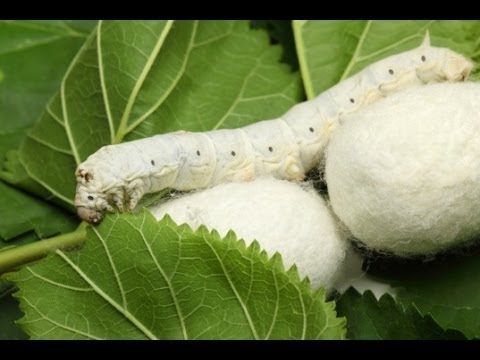Feeding silkworms. Over 600 farmers are involved in silkworm farming in Kenya. Photo courtecy.
The government in partnership with the Japan International Cooperation Agency (JICA) has established a National Sericulture Research Centre at the Kenya Agricultural and Livestock Research Organization (KALRO) stations at Kakamega and Kibos to promote farming of silkworms which are tolerant to bad weather, a condition which has seen western farmers lose in maize and sugarcane production.
The five-year partnership is to see a further research on viability of sericulture (the rearing of silkworms for production of raw silk) using biological and molecular genetic technology in a bid to increase silk production in the country.
“Silk farming is a good venture that can rescue smallholder farmers off poverty as products from silk are of good price and could improve our Gross Domestic Product (GDP) as compared to foreign exchange earnings from exportation of coffee, tea and pyrethrum,” said Kasina Muo, the Head of National Sericulture Research Centre.
RELATED STORY: Women group spins income with silkworm rearing
Currently there are 700 silkworm farmers in the country who could be earning millions of shillings out of the venture.
“In the world market, a garment made of silk costs $133-150 which is approximately Sh13,300-15,000, with major producing countries being China, India, Uzbekistan, Brazil, Japan, Thailand, Vietnam and Iran,” said Muo.
In western region, silkworm farming is practiced in Budalang’i, Ikolomani, Busia town, Kakamega Central and Emuhaya. However, there are 250 acres under sericulture spread Western, Nyanza, Rift Valley and Coastal regions of Kenya.
Over 600 farmers are involved in sericulture in Kenya and annual production is less than two tonnes of dried cocoons, while the national potential is over 10,000 metric tonnes.
Kelvina Asaali, a silk farmer and member trainer at Kakamega Forest Silk and Honey Market abandoned maize farming in 2016 and now she is one of the few Kenyans from the region doing sericulture.
RELATED STORY: Scientists target silkworms to contain Malaria

Silkworm farming does not require huge tracts of land, but farmers prefer the conventional maize farming despite the growing export markets for silkworm products,” said Asaali.
With sericulture, farmers do not struggle finding market for their produce like in maize and other produce. The International Centre for Insect Physiology and Ecology (ICIPE) buys dry cocoons from farmers and exports them.
According to Asaali a kilo of grade A dry cocoons goes for Sh600, grade B fetches Sh500 while grade C earns Sh325 after every month of harvesting. Dry cocoons earn more than wet ones.
RELATED STORY: Worms churn garbage to \’gold\’ for farmers
Generally, wet silk cocoon goes for Sh200 per kilo while dry ones are sold at Sh415 a kilo.
Some of the export markets include Japan, UK and France though silk produced in Kenya goes to the domestic cottage industry and is not sufficient to meet even that demand.
Silkworms take 30 days to mature.